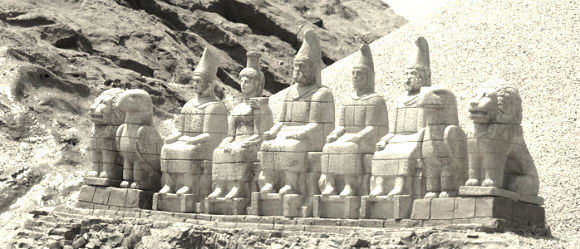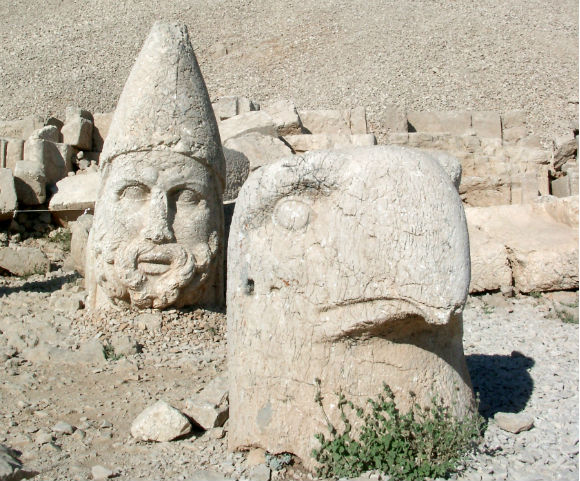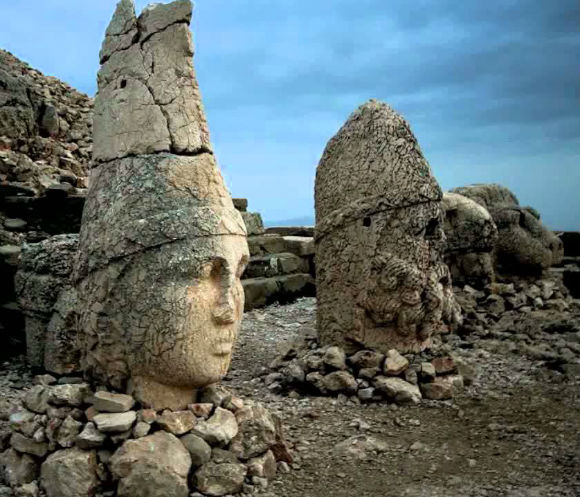Nemrut is a 2,134 m (7,001 ft) high mountain in southeastern Turkey, notable for the summit where a number of large statues are erected around what is assumed to be a royal tomb from the 1st century BC.
Location and description
The mountain lies 40 km (25 mi) north of Kahta, near Adıyaman. In 62 BC, King Antiochus I Theos of Commagene built on the mountain top a tomb-sanctuary flanked by huge statues (8–9 m or 26–30 ft high) of himself, two lions, two eagles and various Greek, Armenian, and Iranian gods, such as Hercules-Vahagn, Zeus-Aramazd or Oromasdes (associated with the Iranian god Ahura Mazda), Tyche, and Apollo-Mithras. These statues were once seated, with names of each god inscribed on them. The heads of the statues have at some stage been removed from their bodies, and they are now scattered throughout the site.
The pattern of damage to the heads (notably to noses) suggests that they were deliberately damaged as a result of iconoclasm. The statues have not been restored to their original positions. The site also preserves stone slabs with bas-relief figures that are thought to have formed a large frieze. These slabs display the ancestors of Antiochus, who included both Greek and Persians.
The same statues and ancestors found throughout the site can also be found on the tumulus at the site, which is 49 m (161 ft) tall and 152 m (499 ft) in diameter. The statues appear to have Greek-style facial features, but Persian clothing and hairstyling.
The western terrace contains a large slab with a lion, showing the arrangement of stars and the planets Jupiter, Mercury and Mars on 7 July 62 BC. This may be an indication of when construction began on this monument. The eastern portion is well preserved, being composed of several layers of rock, and a path following the base of the mountain is evidence of a walled passageway linking the eastern and western terraces. Possible uses for this site is thought to have included religious ceremonies, due to the astronomical and religious nature of the monument.
The arrangement of such statues is known by the term hierothesion. Similar arrangements have been found at Arsameia on Nymphaios at the hierothesion of the father of Antiochus, Mithridates I Callinicus.
Ancient History
When the Seleucid Empire was defeated by the Romans in 190 BCE at the Battle of Magnesia it began to fall apart and new kingdoms were established on its territory by local authorities. Commagene being one of the Seleucid successor states occupied a land in between the Taurus mountains and the Euphrates. The state of Commagene had a wide range of cultures which left its leader from 62 BC – 38 BC Antiochus I to carry on a peculiar dynastic religious program, in which it included not only Greek and Persian deities but Antiochus and his family as well. This religious program was very possibly an attempt of Antiochus to unify his multiethnic kingdom and secure his dynasty’s authority.
Antiochus supported the cult as a propagator of happiness and salvation. Many of the monuments on Mount Nemrud are ruins of the imperial cult of Commagene. The most important area to the cult was the tomb of Antiochus I, in which was decorated with colossal statues made of limestone. Although the Imperial cult did not last long after Antiochus, several of his successors had their own tombs built on Mount Nemrud. For around half of the year, Mount Nemrud lays covered in snow which in effect has increased its weathering which has in part caused the statues to fall in ruin.
Modern history
The site was excavated in 1881 by Charles Sester, a German engineer assessing transport routes for the Ottomans. Subsequent excavations have failed to reveal the tomb of Antiochus. This is nevertheless still believed to be the site of his burial. The statues, all of them “beheaded”, have not been restored to their original condition.
Sights in Nemrut Mountain National Park
In 1987, Mount Nemrut was made a World heritage site by UNESCO. Tourists typically visit Nemrut during April through October. The nearby town of Adıyaman is a popular place for car and bus trips to the site, and one can also travel from there by helicopter. There are also overnight tours running out of Malatya or Kahta.
Nemrut Mountain Park Eastern Terrace
Beyond the building, hike 600m (about 20 minutes) over the broken rock of the stone pyramid to the western terrace. Antiochus I Epiphanes ordered the construction of a combined tomb and temple here. The site was to be approached by a ceremonial road and was to incorporate what Antiochus termed ‘the thrones of the gods’, which would be based ‘on a foundation that will never be demolished’.
Antiochus planned this construction to prove his faith in the gods, and in so doing assumed that upon his death his spirit would join that of Zeus-Ahura Mazda in heaven.
As you approach, the first thing you see is the western temple with the conical funerary mound of fist-sized stones behind it. At the western temple, Antiochus and his fellow gods sit in state, although their bodies have partly tumbled down, along with their heads.
From the western terrace it’s five minutes’ walk to the eastern terrace. Both terraces have similar plans, with the syncretistic gods, the ‘ancestors’ of Antiochus, seated. From left to right they are Apollo, the sun god (Mithra to the Persians; Helios or Hermes to the Greeks); Fortuna, or Tyche; in the centre Zeus-Ahura Mazda; then King Antiochus; and on the far right Heracles, also known as Ares or Artagnes. The seated figures are several metres high, their heads alone about 2m tall.
Low walls at the sides of each temple once held carved reliefs showing processions of ancient Persian and Greek royalty, Antiochus’ ‘predecessors’. Statues of eagles represent Zeus.
Eski Kale (Arsameia)
About 1.5km further, the main road forks left 2km to Eski Kale, the ancient Commagene capital of Arsameia. Nearby is the park entrance for Arsameia and summit access (TL8).
At Eski Kale there is a large stele depicting Mithras (or Apollo), the sun god. Further along are the bases of two stelae depicting Mithridates I Callinicus, with Antiochus I, the taller stele, holding a sceptre. Behind here, a cave entrance leads to an underground chamber built for Mithras-worshipping rites.
Further uphill is a stone relief portraying Mithridates I shaking hands with the ancient hero Heracles. Adjacent, another cave temple descends 158m through the rock; the steps into the temple are dangerous. The long Greek inscription above the cave describes the founding of Arsameia; the water trough beside it may have been used for religious ablutions.
On the hilltop are the ruined foundations of Mithridates’ capital.
Karakuş Tümülüs
Highway D360, marked for Nemrut Dağı Milli Parkı , starts in Kahta next to the Hotel Kommagene. After a few kilometres, the road forks left 1.5km to Karakuş Tümülüs, built in 36 BC. A handful of columns ring the mound – there were more, but the limestone blocks were used by the Romans to build the Cendere Bridge. An eagle tops a column at the car park, a lion tops another around the mound, and a third has an inscribed slab explaining that the burial mound holds female relatives of King Mithridates II.
Yeni Kale
Eski Kahta, also known as Kocahisar, is overlooked by castle ruins. Although there was once a palace here, built at the same time as the Commagene capital of Arsameia on the other side of the ravine, what you see today is the ruins of a 13th-century Mamluk castle, Yeni Kale (New Fortress). There are some Arabic inscriptions above the main and only gateway. You can climb up to look at the castle, but make sure you’re wearing appropriate shoes and watch your step.
At the base of the path up to the castle is the Kocahisar Halı Kursu (Kocahisar Carpet Course), a rudimentary workshop where local women learn carpet-weaving techniques to keep the tradition alive. They don’t sell the carpets here but don’t usually mind if you poke your head in to have a look.
Cendere Bridge
Some 10km from the Karakuş Tümülüs is a modern bridge over the Cendere River. To the left you’ll see a magnificent humpback Roman bridge built in the 2nd century AD. The surviving Latin stelae state that the bridge was built in honour of Emperor Septimius Severus. Of the four original Corinthian columns (two at either end), three are still standing.
Kocahisar Carpet Course
At the base of the path up to Yeni Kale is the Kocahisar Halı Kursu (Kocahisar Carpet Course), a rudimentary workshop where local women learn carpet-weaving techniques to keep the tradition alive. They don’t sell the carpets here but don’t usually mind if you poke your head in to have a look.
Nemrut Mountain Park Entrance
By the time you arrive at the car park and café you’re well above the tree line. The Nemrut Dağı park entrance is 200m up from the Çeşme pension and 2.5km before the junction with the short cut to Arsameia.
Summit
The park entrance is 200m up from Çeşme Pansion and 2.5km before the junction with the short cut to Eski Kale. Beyond the building, hike 600m (about 20 minutes) over the broken rock of ther stone pyramid to the western terrace. Antiochus I Epiphanes ordered the construction of a combined tomb and temple here. The site was to be approached by a ceremonial road and was to incorporate what Antiochus termed ‘the thrones of the gods’, which would be based ‘on a foundation that will never be demolished’.
The first thing you see is the western temple with the conical funerary mound of fist-sized stones behind it. Antiochus and his fellow gods sit in state, although their bodies have partly tumbled down, along with their heads.
From the western terrace it’s five minutes’ walk to the eastern terrace. Here the bodies are largely intact, except for the fallen heads, which seem more badly weathered than the western heads. On the backs of the eastern statues are inscriptions in Greek. Both terraces have similar plans, with the syncretistic gods, the ‘ancestors’ of Antiochus, seated. From left to right they are Apollo, the sun god (Mithra to the Persians; Helios or Hermes to the Greeks); Fortuna, or Tyche; Zeus-Ahura Mazda in the centre ; then King Antiochus; and on the far right Heracles, also known as Ares or Artagnes.
Low walls at the sides of each temple once held carved reliefs showing processions of ancient Persian and Greek royalty, Antiochus’ ‘predecessors’. Statues of eagles represent Zeus.
Eski Kahta (Kocahisar) & Yeni Kale
About 5km from the bridge is a 1km detour to Eski Kahta. There was once a palace here, but what’s now evident are the ruins of a 13th-century Mamluk castle, Yeni Kale (New Fortress). The castle was being renovated at the time of writing and due to reopen in late 2012. After Yeni Kale, cross the Kahta (Nymphaios) River to see the old road and the graceful Seljuk Bridge.
Nemrut Mountain,





I purchased a tour from Adana (Incirlik Air Base) for $120. We departed on a 5 hour bus ride to get to "Hotel Nemrut," a dive of a hotel. It was all-inclusive with meals, all terrible, and I'm not even a picky eater (if you take this tour, bring food).
They wake us up at 2:00 AM in order to…
We visited Mt. Nemrut at sunrise, so we arrived to the place when it was still dark. Going up is a small hike but not strenuous, the last part just got really windy. Remember to dress in warm clothes and bring a hat (that won't fly away). We visited in July and it was nearly 50C down there but the…
I did a 2 night / 3 day tour Mt. Nemrut Tour through Nese Tours which started in Goreme. I went with a tour – vs. self-guided – because it would have taken twice as long to see all the sights on my own using public transportation, albeit much cheaper. I took the last tour of the season (mid-October).
Likes:…
We went up in early June. It was a bit cold and windy at the mountain, so jackets are required. The walk up was easy enough for our 4 year old to do by himself. The views are amazing and it was definitely worth the trip to Adiyaman province from Istanbul to visit this. On the way back, drive the…
A tribute to maybe history's greatest and most deluded megalomaniac. The burial site of Antiochus, the insignificant regional King who declared himself to be the equal of Zeus and had a virtual pyramid built atop of the highest mountain in the region, with huge statues of himself and the pantheon of Gods sitting together.
Remarkably intact considering the amount of…
We visited Mt Nemrut via the Malatya side through Gunes Motel.
We boarded the motel bus in the city centre and were on our way.
After 2.5hrs, we arrived at Gunes Motel and were settled into our simple room with distant view of the Nemrut.
At 5 sharp, we were driven to near the summit of Mt Nemrut together with…
For centuries, the heads of the heads of state sat on their own shoulders and bodies above this royal burial mound – this huge pile of rocks and stones on the summit of Nemrut Dağı (Mount Nemrut 2,134 m – 7,001 ft).
Earthquakes shook the heads off the shoulders. Now, along with their lion and eagle guardians, the two-meter-tall heads…
Made the trip to Nemrut in June and was so glad I did it. Yes, it does take a while to get to as it's nowhere near the rest of the main tourist sites, but when you couple seeing Nemrut along with all the other interesting sites in the area, it really is a different part of Turkey that you…
A fantastic place to be for sunrise and sunset. Pray for good weather and few tourists.
An easy way to be there for both sunrise and sunset is to take a tour out of Malatya. Our guide was "Romeo" and he was really great. We all stayed at the Gunes and the advantage is you get more time on the…
Wonderful place with wonderful people! Very extreme, a piece of the ancient times. Not so hard walking to the top, cca 500 meters long to 2000meters high. Look around, amazing! I suggest you to stay under the top, in the last Hotel on the way to Nemrut: Nemrut Kervansaray. It is a simply Hotel, and there is camping place, too….